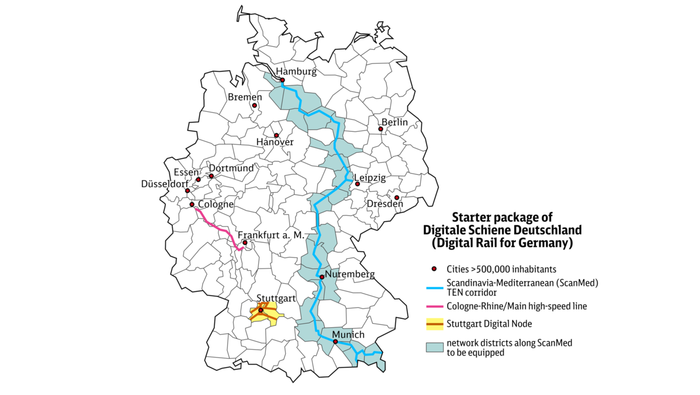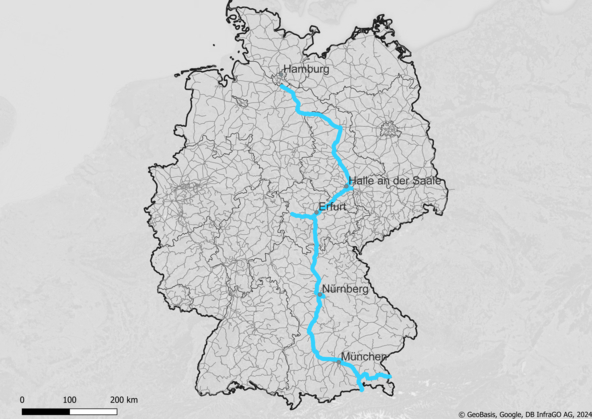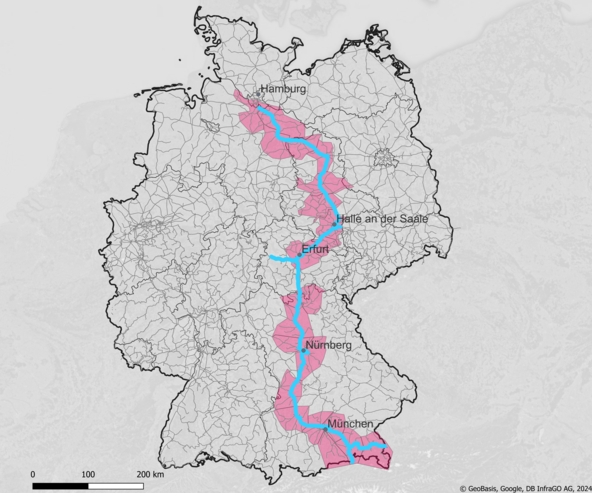
Corridor Scandinavian-Mediterranean (ScanMed)
By equipping the Corridor ScanMed with ETCS, an interoperable rail network will be created in the heart of Europe, enabling trans-European transit. This pioneering project connects important cities and economic areas in Germany with Scandinavia and the Mediterranean and thus marks a milestone in the expansion of cross-border traffic safety using ETCS. The Corridor ScanMed is part of the starter package.
Project duration
Route data
| Line from | Padborg (DK border) |
|---|---|
| Line to | Kiefersfelden and Freilassing (AT border) |
| Kilometers of line to be equipped | 5,000 km |
| Route number(s) | Includes almost 2,500 route numbers |
Planned actions
| ETCS | Level 2 without signals |
|---|---|
| Interlocking(s) | ETCS-compatible interlockings, preferably DSTW |
| Scope of equipment |
|
Contact
Disclaimer
The dates shown are legally non-binding forecasts based on the current status. The forecasts are in no way intended to establish any kind of legal claim whatsoever that completion will take place by the specified date and that use will be possible. For these reasons, the information should also not be used to make or prepare business decisions, for example, but not conclusively, with regard to the vehicle equipment or the compatibility between the vehicles and the infrastructure. If you have any questions, particularly regarding technical network access or obtaining binding information, please contact your customer advisor.
Most of the infrastructure projects are still in the planning phase, which means that the information provided on these pages reflects the current planning status and is updated regularly.
Alongside the Fast-Track Programme, the starter package marks the start of the rollout of Digitale Schiene Deutschland (DSD). With a target horizon of 2030, the routes will be equipped with the European Train Control System (ETCS) and digital interlockings (DSTW: Digitale Stellwerke) in three projects and thus comprehensively digitised. In this way, the technologies, some of which date back to the 19th century, will be replaced. The knowledge gained from the starter package will be incorporated into the rollout of DSD for the entire German rail network.
The Corridor Scandinavian-Mediterranean (ScanMed) is one of the three projects in the starter package. The ETCS equipment will create an interoperable rail network in the middle of Europe that will enable trans-European transit. The corridor ScanMed is one of a total of nine Trans-European Networks core network corridors (TEN core network corridors), which form the central trans-European transport network of the European Union. It links major cities and economic areas in Germany and Italy with Scandinavia and the Mediterranean. In Germany, the main route of the corridor stretches from Hamburg via Erfurt to Munich and the Austrian border crossings in the south. The corridor is particularly important for freight transport.
The conversion of the German part of the corridor covers around 5,000 kilometers of track and approx. 34,500 control units, such as signals or point machines. The upgrade therefore not only affects the main route of the corridor, i. e. the direct route from north to south, but also the 21 network districts through which the German rail network is divided at DB InfraGO AG. The aim is for all trains to be able to travel the route from Padborg on the Danish border to Kiefersfelden and Freilassing on the Austrian border with ETCS by the time the main route is commissioned in 2030.
Various measures are necessary to ensure that the line can be used with ETCS throughout. The main route and the adjacent network districts must be fully equipped with the ETCS Level 2 without signals (ETCS L2oS), modern interlocking technology and the integrated control and operating system (iLBS: integriertes Leit- und Bediensystem) as the future operating system. The aim is to avoid the duplication of old and new infrastructure technology. Existing interlockings that are not compatible with ETCS will therefore be replaced by digital interlockings (DSTW: Digitale Stellwerke). Lines already equipped with ETCS will be upgraded to ETCS Baseline 3. Baseline refers to the software for fulfilling certain functions in order to ensure rail operations under ETCS from a technical perspective. There are currently three different baselines for ETCS, each with a different range of functions. The upgrade to Baseline 3 is necessary to enable consistent operation with ETCS L2oS. This is accompanied by adjustments to the interlockings and operations centers. The construction of ETCS route control centers (RBC: Radio Block Centre) is also part of the project scope. Running under ETCS L2oS also requires sufficient radio coverage to be ensured. A powerful and secure IP network is required for digital control via DSTW, which is why the project is carrying out extensive measures in the area of telecommunications and cable systems.
Finally, the Operational Control Strategy (BSS: Betriebssteuerungsstrategie) in the affected network districts is also taken into account in the planning. The BSS includes the construction of standardised buildings for the operational centers (BSO: Bedienstandorte) and technical systems centers (TSO: Technikstandorte), from which the route will be controlled in future.
The starter package is expected to run until 2030 and aims to comprehensively digitalise rail lines through ETCS and DSTW. This will replace a lot of old systems, some dating back to the 19th century. The lessons learned of the starter package will be incorporated into the rollout of Digitale Schiene Deutschland to the entire German rail network.
Increasing capacity throughout the European network without building new tracks
Digitale Schiene Deutschland is being launched to create uniform, digitally controlled train traffic throughout Europe. The European Train Control System (ETCS) is an essential building block for an interoperable, cross-border rail network.
Three projects were selected after McKinsey completed the feasibility study on the rollout of ETCS and digital interlockings (DSTW: Digitale Stellwerke) in autumn 2018. The technologies have the potential to significantly increase capacity and quality within a few years. These projects form the starter package which is the gateway to Digitale Schiene Deutschland.
Starter package projects
The following two projects are part of the starter package in addition to the Corridor Scandinavian-Mediterranean (ScanMed):
- Stuttgart Digital Node (DKS: Digitaler Knoten Stuttgart),
- Cologne–Rhine/Main high-speed line (SFS KRM: Schnellfahrstrecke Köln–Rhein/Main).



The ScanMed project pursues several goals: It forms the foundation for the modernisation and standardisation of technologies, such as interlocking technology, and thus drives forward the digitalisation of rail transport. In addition, comprehensive performance analyses are to be used to identify opportunities to improve the quality and thus the availability and punctuality of rail operations. The Bundesverkehrswegplan 2030 and the Deutschlandtakt will serve as a guideline. At the same time, the project aims to make the planning and construction phases more efficient, for example through the digitalisation of the planning process, the use of artificial intelligence and early and comprehensive coordination with corresponding projects.
The three projects in the DSD starter package - ScanMed, the Cologne - Rhine/Main high-speed line and the Stuttgart Digital Node - together form the basis for the rollout of Digitale Schiene Deutschland (DSD). In this pilot project, the operational-technical target image (BTZ: Betrieblich Technisches Zielbild) of DSD is being realised for the first time on the basis of the Basis-Release-Plus. The Basis-Release-Plus, in turn, summarises key regulatory development stages of digital technologies - from ETCS and DSTW to telecommunications and rail-specific IT - for the implementation of the DSD starter package. In addition, the ScanMed project is doing pioneering work by testing and directly evaluating new methods in project management as well as in planning and construction processes. The decisive added value lies in the fact that all the knowledge gained is incorporated into the implementation of the DSD rollout.